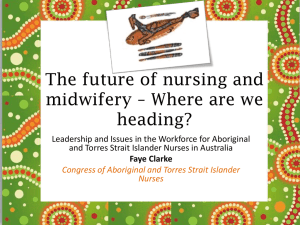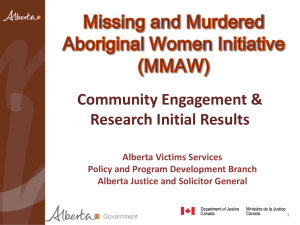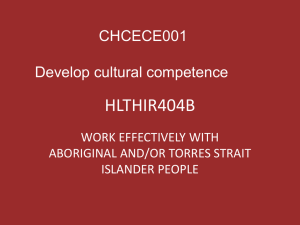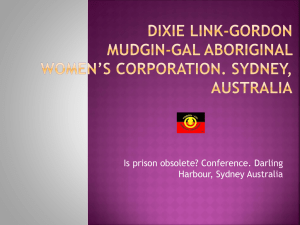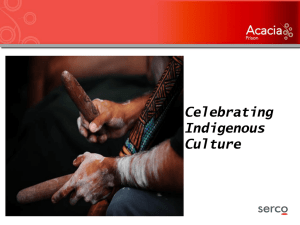PowerPoint
advertisement
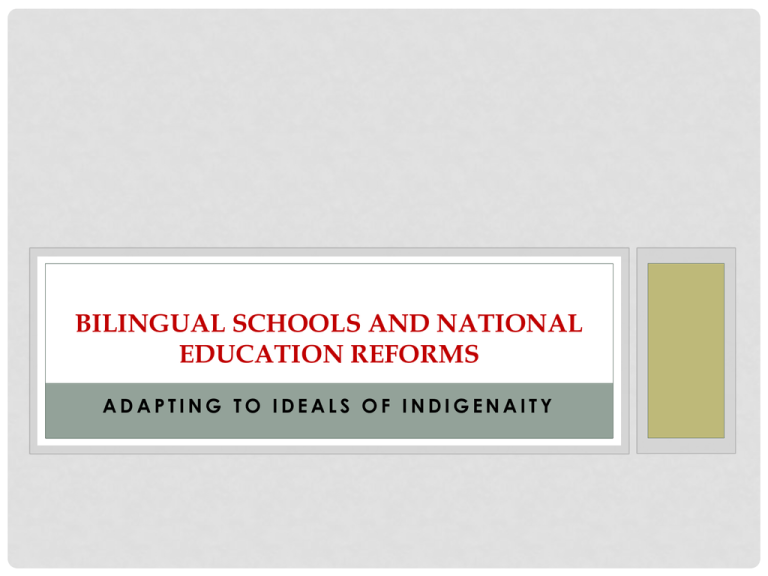
BILINGUAL SCHOOLS AND NATIONAL EDUCATION REFORMS ADAPTING TO IDEALS OF INDIGENAITY INDIGENOUS EDUCATION KEY REFORM TENSIONS Key national and NT Indigenous education reform tensions include instituting progressive reforms in the context of a society that by design produces inequality, and the way Indigenaity is rationalised and problematized in the context a national cultural identity and history colonisation. Two themes occupy this space: 1. Indigenous remote schools are situated broadly across sociocultural and socioeconomic frames that produce structural gearing in opposition to reform ideals and ongoing attempts in advancing the national education profile. 2. Indigenous identities situated within national racial discourses that negatively pathologise Indigenaity as inferior and archaic. This political environment permeates social justice broadly and undermines education and school reform attempts. INDIGENOUS SCHOOLING AND A NATIONAL DISCOURSE Perversions in public policy are an ongoing feature of a capitalist economy and its layering properties, expressed in contests of social justice, but also in its production and convolution between economic and social policy. A net outcome of this dynamic has been profound, and amongst its key expressions have been: • Ongoing colonisation and assimilation that is tearing at a national identity and consciousness. The absence of a clear and national articulation of Indigenaity impacts all Australians • An intellectually-dishonest and incongruent construction of education for Indigenous Australians. This is a key manifestation of a national fragmented Policy environment • Insignificant change in the patterning of educational outputs, most notably in remote, traditionally-oriented Aboriginal contexts • Circular movement of policy responses leading to ideological and policy reform inertia • Increased centralised approaches founded on quantitative domains, predicated on increased prescription, accountability and domination of schools by governments that have disempowered schools and Indigenous members from the process (1) EMPLOYING MODEL FRAMEWORK IN ORGANISATIONAL GROWTH (TECHNICAL-RATIONAL CONVERGENCE) National policy frameworks Synergy and consistency exists between all layers Quality Leadership, management and administration Quality developmental intervention programs National and local educational funding levels Quality teaching/learning Human programs capital Social capital Quality Relationships Quality teaching, pedagogi cal practices Quality resources Quality whole of school resources Local community demographic environment Quality whole school strategic planning NT and district policy frameworks EVOLUTION OF ORGANISATIONAL COMPLEXITY (DECENTRALISATION) Technical specialisation structures: tensions across teaching, curriculum, assessment, reporting frames school Social structures: tensions across relationships and social complexity Business structures: tensions across finance, legal and HR frames SCHOOL CHANGE WITHIN DEMOGRAPHIC CONTEXTS Demographic contexts influence the type and trajectory of change. Where schools ignore or are unable to navigate the demographic forces impacting, they struggle and move very little in regards to organisational outputs. District policy & resource environment Mental and physical health profile Socioeconomic & sociocultural forces School Family dynamics Cultural capitalalignment with school AUSTRALIAN EDUCATION (REFORMS SITUATED ACROSS A STRATIFIED SOCIETY) 10,500 schools nationally In this context of national structural tension, purpose is a foundation to engagement. Patterns of educational inequality indicate anchoring of schools to demographic environments for urban and remote schools. Urban schools situated within capitalist expressions Remote schools situated within traditionally-oriented Indigenous expressions DEMOGRAPHY AND SCHOOLING CHANGE All reforms and their attempts at change are designed to prepare children for a constantly changing and challenging world. This means moving children, mostly from struggling families, to do better than their demographic experiences. Focus of reforms ICSEA A stratified or layered Australian capitalist society produces inequality as a key bi-product Eaton & Stillwell (1992) point to an explosion from the mid 1980’s, as Australia underwent financial deregulation, producing pronounced class layering. CIRCLES AND TRIANGLES: NAVIGATING CHANGE Governments Bureaucracies (service enablers) ICSEA Schools (service providers) SCHOOL SOCIAL& ORGANIC DYNAMICS (A STRUCTURAL PROPENSITY TO IMPLODE) Schools in low ICSEA contexts are naturally cycling. Schools require significant energies to maintain internal consistency (let alone develop) and are predisposed to internal decay. Peaks + Fluctuations in funding, staff, cultural atmosphere, resources, reforms Community is a key site to draw energy and build resiliency within schools Troughs - ICSEA CONTEXTUAL TRENDS SES: driving oppositional forces in reform High Challenges Organisational complexities-compensating context Aggression Staff Attrition Rates Recruitment Challenges Low Low ICSEA High ICSEA Patterns changing against High ICSEA as broad societal impacts continue ADDRESSING THE SOCIAL EPIPHENOMENA SPIRALLING OUT OF INSTITUTIONALISATION National Safe Schools Policy Framework – constructing and maintaining standards Special education, academic, social and emotional, children in FACS care School-based police, school, cluster, hub and departmental leadership High quality relationships Repelling high-level aggression Behaviour management Policy (2) REMOTE SCHOOLS SITUATED WITHIN A NATIONAL DISCOURSE OF POLICY INTERACTIONS Since the early 1990’s centralisation has propelled a constant layering of national systemic policy levers in mobilising schools to produce outputs beyond their district envelopes. These major shifts have included: • Economic doctrine has accelerated in sync with a move toward modelling public schools against private business models • Decentralisation has resulted in greater levels of centralised controls with schools faced with increased responsibilities over education • Centralised controls have been accompanied with increased levels of technical prescription and standards in an effort to move the teaching workforce toward a defined professional group • The major focus of reforms have been predicated on a construct of strengthening the internal features of schools as the key basis for countering the inequality manufactured across communities • Reforms have largely resulted in increased demand for higher levels of technical prescription across a stressed workforce. This framing is challenged across ICSEA and remote Indigenous education DATA TRENDS: NT INDIGENOUS POPULATION PROFILE State Population Percentage of Total Indigenous Population 0-24 years ATSI (total) Percentage of Each State Population NSW 172,620 (87,378) (29.7%) 2.5% Vic 37,990 (18,920) (6.4%) 0.7% QLD 155,825 (83,843) (28.5%) 3.6% SA 30,430 (15,903) (5.4%) 1.9% WA 69,664 (39,687) (13.5%) 3.1% Tas 19,625 (10,594) (3.6%) 4.0% NT 56,776 (30,090) (11.9%) ACT 5,185 (2,453) (0.8%) NT Demography: expanding ideals of social justice, challenging colonisation 26.8% 1.5% Source: ABS 2011 DATA TRENDS: NT INDIGENOUS SOCIAL STATISTICS NT Total Indigenous Population 56,776 NT Remote Indigenous Population 45,540 Median Age 23 Average occupants/dwelling 4.7 NT Demography: expanding ideals of social justice, challenging colonisation Source: ABS 2011 REMOTE SCHOOLS SITUATED WITHIN A NATIONAL DISCOURSE OF POLICY INTERACTIONS Governance and inclusion Amalgamation of Community Councils into new structures called Shires has dramatically changed the governance landscape in the Northern Territory, disconnecting Aboriginal communities from their local governments and consequently from decision-making regarding service delivery. The Emergency Response occurred around the same time as the Shires were introduced and to Aboriginal peoples in the Northern Territory, they appeared part of the same assault on control over their communities. These policies, along with a range of other changes imposed by governments have resulted in widespread disempowerment and distrust of governments. I consider the evidence generally on the health impacts of disempowerment and then specifically on the suicide rates in the Northern Territory. The implication that disempowerment and rising numbers of suicide attempts, particularly in young people, in the Northern Territory are connected is hard to escape and is extremely upsetting. (ATSI Social Justice Commissioner, 2012 Social Justice Report). 2012 SOCIAL JUSTICE REPORT ABORIGINAL AND TORRES STRAIT ISLANDER COMMISSIONER Knowing what should occur has been rebounding for a number of years. Recent reiterations include: • 1.2 That the Australian Government engage with Aboriginal and Torres Strait Islander peoples to develop a strategy for implementing the United Nations Declaration on the Rights of Indigenous Peoples. • 1.3 That the Australian Government commit to ongoing funding support for the international engagement of Aboriginal and Torres Strait Islander peoples to advocate for their human rights. • 1.4 I reiterate the Commission’s recommendation that the United Nations Declaration on the Rights of Indigenous Peoples be included in the definition of human rights in the Human Rights (Parliamentary Scrutiny) Act 2011. • 1.5 That all political parties recommit to constitutional recognition of Aboriginal and Torres Strait Islander peoples and support the recommendations of the Expert Panel 2012 SOCIAL JUSTICE REPORT ABORIGINAL AND TORRES STRAIT ISLANDER COMMISSIONER • 2.1That the Australian Government acknowledges that effective Indigenous governance is central to sustainable development in Aboriginal and Torres Strait Islander communities. • • 2.2. That the Australian Government builds its own capacity to enable and support effective Indigenous governance. • 2.3 That all governments properly resource Aboriginal and Torres Strait Islander communities to strengthen their contemporary governance structures. This resourcing must be part of a new relationship between Aboriginal and Torres Strait Islander peoples and governments based on genuine power-sharing and partnership 2012 SOCIAL JUSTICE REPORT ABORIGINAL AND TORRES STRAIT ISLANDER COMMISSIONER • 3.1 That the Australian and Northern Territory Governments invest in developing and strengthening governance structures and systems in Northern Territory Aboriginal communities to ensure they are culturally legitimate and aligned to community needs and priorities. • 3.2 That any reforms to governance arrangements in the Northern Territory be done in genuine consultation, and where appropriate in partnership, with the Aboriginal communities affected. Consultations should be undertaken in accordance with the features of meaningful and effective consultation contained in the Native Title Report 2010 DATA TRENDS: NT SCHOOL ATTENDANCE OUTCOMES Middle Years attendance rates 2010-11 2011-12 89% 89.6% 64.2% 64.1% Non-Indigenous - 79.6% Indigenous - 25.4% Non-Indigenous 87% 87% Indigenous 69% 65% Non-Indigenous - 67% Indigenous - 22% Non-Indigenous Indigenous Students attending > 80% Senior Years average attendance rates Students attending > 80% Source: 2011-12 DET Annual Report DATA TRENDS: NT SCHOOL ATTENDANCE OUTCOMES Preschool average attendance rates 2010-11 2011-12 Non-Indigenous 90% 88% Indigenous 64% 62% Non-Indigenous - 81% Indigenous - 26% Students attending > 80% Primary school average attendance rates Non-Indigenous 93% 93% Indigenous 69% 70% Non-Indigenous - 92% Indigenous - 38% Students attending > 80% Source: 2011-12 DET Annual Report DATA TRENDS: NT STUDENTS ACHIEVING NATIONAL MINIMUM STANDARD (NAPLAN) Reading Year 2010-11 2011-12 Non-Indigenous 3 90% 87% Indigenous 3 53% 46% Non-Indigenous 5 87% 86% Indigenous Year 5 34% 29% Non-Indigenous 7 91% 90% Indigenous 7 43% 52% Non-Indigenous 9 89% 83% Indigenous Year 9 36% 41% Source: 2011-12 DET Annual Report DATA TRENDS: NT STUDENTS ACHIEVING NATIONAL MINIMUM STANDARD (NAPLAN) Writing Year 2010-11 2011-12 Non-Indigenous 3 - 91% Indigenous 3 - 43% Non-Indigenous 5 - 85% Indigenous 5 - 28% Non-Indigenous 7 - 80% Indigenous 7 - 25% Non-Indigenous 9 - 72% Indigenous 9 - 22% Source: 2011-12 DET Annual Report DATA TRENDS: NT STUDENTS ACHIEVING NATIONAL MINIMUM STANDARD (NAPLAN) Numeracy Year 2010-11 2011-12 Non-Indigenous 3 93% 91% Indigenous 3 51% 59% Non-Indigenous 5 93% 91% Indigenous Year 5 42% 47% Non-Indigenous 7 92% 90% Indigenous 7 44% 47% Non-Indigenous 9 90% 88% Indigenous Year 9 39% 45% Source: 2011-12 DET Annual Report DATA TRENDS: NT SENIOR YEARS STUDENTS VET AND NTCE Senior Years 2010-11 (number) 2011-12 (number) Non-Indigenous Enrolments average attendance 87% 3428 (65.7%) 3484 (65.6%) Indigenous Enrolments average attendance 64% 1784 (34.2%) 1820 (34.3%) Non-Indigenous 640 723 Indigenous 99 106 - 604 - 71 Achieving NTCE Achieving VET Certificate I or II Qualification Whole cohort Achieving VET Certificate III Qualification Whole cohort Source: 2011-12 DET Annual Report INDIGENOUS REGIONAL BOUNDARIES Source: ABS 2007 INDIGENOUS NATIONAL POPULATION SPREAD Source: ABS 2008 INDIGENOUS LANGUAGES Language is not only a form of communication, it is also a way of expressing and maintaining culture, knowledge and identity. Aboriginal and Torres Strait Islander languages convey unique meanings and are central to the survival of cultural knowledge • In 2008, 8% of all Aboriginal and Torres Strait Islander children and youth spoke an Aboriginal or Torres Strait Islander language as their main language at home • a further 4% of children and youth could speak an Aboriginal or Torres Strait Islander language, but did not speak one as their main language at home • of children and youth who did not speak an Aboriginal or Torres Strait Islander language as their main language at home, 16% were currently learning to speak one. Source: ABS 2008 INDIGENOUS LANGUAGES Children and youth living in remote areas were far more likely than those living in non-remote areas to speak an Aboriginal or Torres Strait Islander language (42% compared with 4%). • In 2008, 47% of young people living in remote areas (10,700) spoke an Aboriginal or Torres Strait Islander language and 53% (12,300 people) did not speak an Aboriginal or Torres Strait Islander language (including 20% who only spoke a few words). Characteristics of young ATSI language speakers in remote areas. According to the 2008 NATSISS, young people living in remote areas who spoke an Aboriginal or Torres Strait Islander language were less likely than those who did not to: • report binge drinking in the previous fortnight (18% and 34% respectively) • report that they had used illicit substances in the past 12 months (16% and 26% respectively) • have been a victim of physical or threatened with violence in the last 12 months (25% and 37% respectively). BILINGUAL SCHOOLS AND BI-CULTURAL, TWO-WAY PEDAGOGICAL PRACTICE Tensions exist within bilingual schools. These include, but not confined to bilingual schools • Increased specialisation in human resources • Funding and resource modeling (i.e. literacy production centers) • Political endorsement from governments. The number of officially recognized bilingual schools in the NT has reduced from 17 in the late 1980s to nil in 2013 • Endorsement from local Indigenous communities. Not always observed by community members as a functional or choice model in language or cultural maintenance • Incongruence with national delivery and reporting frameworks • Philosophic challenges that question the school as a key site in local languages maintenance (i.e. should reside within the family) AUSTRALIAN PUBLIC POLICY, ECONOMIC POLICY, EDUCATIONAL POLICY (FUTURE OPTIONS) The present expressions of Australian mainstream and Indigenous educational inequality graphically reveal the need to evolve the policy modeling substantially. Beyond the intensification of reforms situated within schools, other options for progressing beyond the present patterns in Indigenous educational inequality include • Intensive amplification and application of social policy frameworks that have greater relevance to contemporary social properties and dynamics of schools • Strengthening district policy environments to meet school organisational properties and evolutions, particularly in access and equity frames • Establishing positive synergies between a national Australian identity and its reconciliation of colonization and Indigenous identities.


